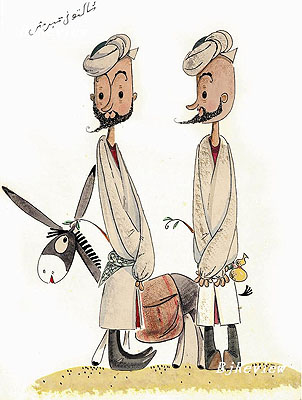
Afanti, a legendary hero who fights for the poor against miserly land barons, is the leading character of the best-known Chinese animation series after his name. The cartoon image of Afanti, a humorous and wise Uygur man riding a donkey, is a lasting childhood memory for many Chinese.
Qu Jianfang, director of the animation series and designer of the cartoon image of Afanti, was therefore given the name of “Father of Afanti.” He was also the first to get Chinese cartoons into the international market and one of the forerunners of exploring the animation derivative market in China.
During the Third China International Cartoon and Animation Festival held in Hangzhou, Zhejiang Province, in late April, Qu sat down with Beijing Review reporter Lu Ling to share his views on the development of China’s cartoon and animation industry and his experiences introducing Chinese cultural works to the Western market. Excerpts of this interview follow:
Beijing Review: China once produced excellent cartoons and animation movies that garnered international recognition, including Havoc in Heaven (with the Monkey King as a hero), but after this, the Chinese animation industry seemed to go into recession. What do you think the main reason for this was?
Qu Jianfang: In the past, most animation works in China were featurettes, and full-length animation movies would be made every several years. All these animation filmlets were presented as pre-shows before formal full-length movies.
But with the marketization of China’s movie industry, the practice of showing animation featurettes before movies was canceled in the mid-1980s, greatly limiting the further development of the animated cartoon industry. Besides, at that time, China had almost no experience in making animation works for television.
In the following 10-plus years, China’s animated cartoon industry mainly contracted production for foreign companies. From then on, Chinese audiences have had the chance to enjoy more and more excellent foreign animation cartoons, but original creations from China were basically a blank.
In your opinion, what is the major shortcoming of China’s animation industry?
After the rapid development of contracted production from the mid-1980s to the mid-1990s, China has become one of the leading animation producers in the world. Now, many foreign cartoon movies or television series, including Walt Disney’s products, are made and processed in China. So, in my opinion, the gap between China and the world’s leading animation countries mainly lies in the area of creative ideas.
Many of the contextual elements of Chinese animation works are related to Chinese culture, and are difficult to understand for foreign audiences. How did you overcome this hurdle and make your cartoon images familiar to overseas audiences?
This is the biggest problem for Chinese animation products entering the international market. Many Chinese cultural elements, if they are not adapted more or less, cannot be fully understood by foreigners. Take the facial make-up in China’s Peking Opera as an example. Extremely stylized in the colors and patterns used, foreign audiences, who don’t have basic knowledge about Chinese culture, certainly find it hard to understand.
But in my view, Chinese animation works should retain their own characteristics; that is to say, let the audience have a feeling for the Chinese style of animation. But in terms of presenting ways and producing methods, they must be internationalized.
Let me give you an example. The animated cartoon filmlet Xiao Liyu Tiao Longmen (A Cyprinoid Jumps Over a Dragon Gate) tells a Chinese fairy tale. But because of cultural differences, the original name of the animation sounds meaningless for foreigners. Finally, the name of the filmlet was translated into The Adventures of a Fish, which is more easily understood by foreign moviegoers.
Second, we have to find common topics that both Chinese and foreign audiences can understand and sympathize with. To do so, in my new animation series Little Afanti, I add some new issues common to an international audience, such as antiterrorism, stock investment and counter-fake activities, hoping to arouse common feelings in all audiences.
Is there any difference between Chinese and foreign animation products in terms of the way they are presented?
Many Chinese animation products used to focus mainly on the function of teaching. But in my opinion, animation and cartoon products do not necessarily need to teach people and they will be ok as long as these works are not harmful, especially to children.
Foreign animation products are inclined to pay attention to humanity and pursue an atmosphere of light-heartedness and happiness. Although there are many things in foreign animation that make people think, they are expressed and presented through art.
Apart from this, in those animation works involving animals, such as the Lion King, animals have characteristics of people, but remain living like animals. But in China, the most common way is to make animals live like mankind, such as making animals dress in people’s clothing.
What kind of talent is urgently needed in the development of China’s animation industry?
Currently speaking, people full of creativity and experience in marketing and promoting animation products are in great demand in China. With the development of the whole industry, people who have creative ideas and know the production and marketing processes very well will be greatly needed. Today, many young people engaged in the animation industry have little chance or experience of participating in all of the stages of the operation flow. |